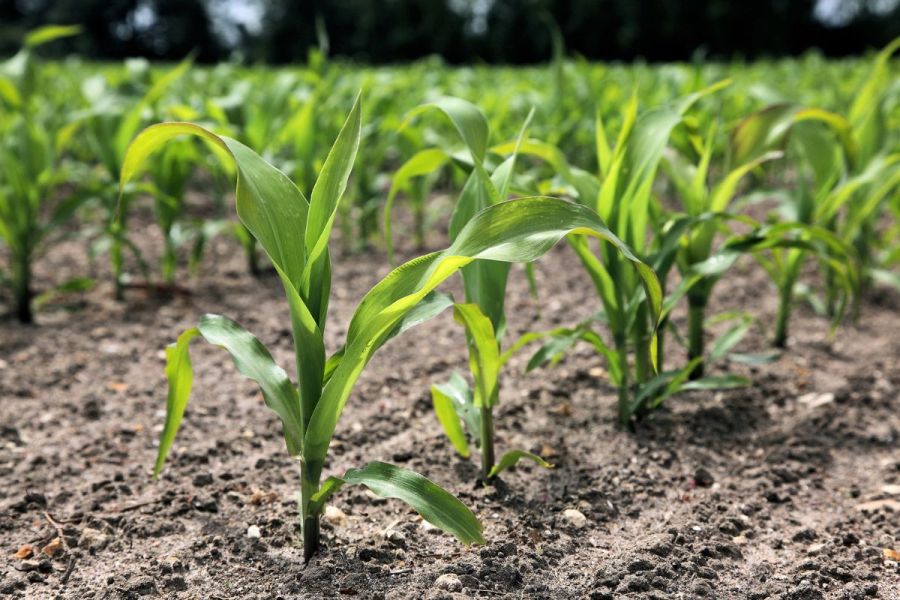Much of what maximises the potential of maize occurs in the spring, with the emphasis being on getting the crop off to the best start. CPM takes a look at the role of nutrition and how best to match the crop’s requirements.
“It’s a case of delivering nutritional requirements as they’re in demand, rather than loading early in the season.” – JON MYHILL
By Janine Adamson
With last year proving difficult for much of the UK’s maize due to cold conditions and a lack of sunlight, could this spring flip its fortune? If growers ensure crops are off to the best start including finessing nutrition, KWS’ Andrew Cook, believes so.
He reminds that most of maize’s potential is built and set in the spring, therefore planting when soil temperatures are right into good seedbed conditions should be the priority.
“Warm soils – 8°C on light soils to 10°C on heavier soils, for 4-5 consecutive days – are the best, drilling into an environment where nutrients can be used well. Because maize is very uncompetitive in its early stages, this means weed control is critical to avoid nitrogen being robbed from the crop,” he says. “As such, pre- and post-emergence herbicide treatments really do pay for themselves.”
However, rewinding a step, he highlights that variety selection is paramount and the aim should be to choose a maize variety based on the constraints of each individual system. “It’s about harvesting at the right time for your rotation, but also when that particular variety has reached its maturity.”
VARIETY SELECTION
“For those with shorter growing seasons this might mean a very early maturing variety such as KWS Temprano (FAO 150) which is in the ultra-early segment. Others may want to grow a larger crop so early maincrop varieties would be most suited, such as KWS Reo (FAO 170) and KWS Papageno (FAO 190). Then at the other end of the spectrum is KWS Granturismo (FAO 220) which is best suited to lighter soils and the highest yielding variety on the maize descriptive list for favourable sites.”
Maize Growers Association (MGA)’s Jon Myhill says with current conditions being improved compared with this time last year, some growers are contemplating drilling now (start of April) – which is at least two weeks ahead of convention.
“Despite last year being a little off putting, mainly due the late drilling many experienced, we continue to see increased interest in maize from both a forage and grain perspective. In addition, with SFI on hold and a rising demand for suitable break crops, maize could fill that gap,” he believes.
“With improved genetics coming through from breeders it means maize can be harvested at a more sensible time in the year to mitigate previous environmental risks such as flooding or soil erosion; it really is holding its own now.”
He echoes Andrew’s sentiment regarding ensuring conditions are optimum. “Soil testing will provide more in-depth analysis, paying particular attention to pH with 6.5-7 being the ideal range for maize and the uptake of soil-based nutrients.
“Then once you know what the crop requires, it’s a case of delivering those nutritional requirements as they’re in demand, rather than loading early in the season,” he advises.
To explain further, Andrew adds that the peak nutritional demand in maize can occur months after a seedbed fertiliser has been applied. “With maize, around 50% of nitrogen is required between 6-leaf stage and tassel emergence; prior to this, uptake is very slow.
“Applying organic manures or slurries are a great way to supply nutrients which are slow-release and are often a good match for the crop’s demand. But regardless of the delivery mechanism, preventing both leaching and volatilisation is key to ensure adequate nitrogen is available to the growing crop, and to also mitigate any environmental concerns,” he says.
One way to achieve this is to use a nitrogen stabiliser, suggests Corteva Agriscience’s Clare Stapley. “The use of nitrogen stabilisers in the UK is growing, but is still reasonably limited. However, high input prices across the board and pressure on demand are bringing their use to the fore.”
The company has been trialling its product Instinct, which has shown a reduction in leaching of around 50%, plus lowering denitrification through greenhouse gases by approximately 45%. How it works is, it slows the conversion of ammonium to nitrate, keeping nitrogen in the root zone for longer.
COMPATIBILITY
Instinct can be incorporated into slurry or digestate before field application or sprayed onto soil independently afterwards. It’s also compatible with various nitrogen sources, requiring a single rate of 1.7 l/ha and good soil contact for effectiveness, adds Clare.
“Applying before ploughing or ahead of rainfall ensures proper incorporation.”
Agrovista’s head of soil health, Chris Martin, says when it comes to farms using both slurry and digestate, nitrogen stabilisers are a no-brainer. “I honestly think their use should be legislated and in time it may be. Many maize farmers use a lot of digestate, which has up to 80-90% of its nitrogen in the ammonium form. Instinct keeps nitrogen available but in its stable form for longer.”
With an NMAX limit of 150kgN/ha, maize often receives less nitrogen than it ideally requires, believes Corteva’s Ryan Came-Johnson. “But by applying Instinct, farmers could potentially apply less artificial nitrogen because they’re getting more from what they are applying and achieving increased nitrogen availability from their manure applications.”
He agrees that maize often receives most of its nitrogen inputs at drilling, yet has a large nitrogen requirement later in its growth stages. “By keeping nitrogen in its most available form for longer, you’re making it more available at the time when maize requires it the most,” he says.
Jon raises that with recent advancements in foliar fertilisers, more options are now available to growers, to ensure maize receives a slow-release of nutrients. “New urea polymer-based products are low-scorch, which is something maize requires which cereals don’t.
“And rather than applying to the seedbed and expecting the crop to find those nutrients months later, you’re feeding it when its most hungry,” he says. “Although seedbed nitrogen is still required, research conducted by the MGA indicates such foliar applications can displace it by up to 20%.
“This is a positive in terms of carbon footprint by reducing potential volatilisation, while proving a cost-effective solution which could save on input spend.”
He says applying fertiliser later in the crop’s life cycle can have a positive impact on yield, plus boosting quality attributes such as dry matter content and starch, as indicated by MGA trial work.
To conclude, Jon highlights that although nitrogen will remain a key factor in maize performance, his watch out for this season is in fact sulphur. “Air conditions are much cleaner now so less sulphur is taken up by plants naturally. For maize, the recommendation is 30kgS/ha along with a nitrogen application.”
This article was taken from the latest issue of CPM. Read the article in full here.
For more articles like this, subscribe here.
Sign up for Crop Production Magazine’s FREE e-newsletter here.




